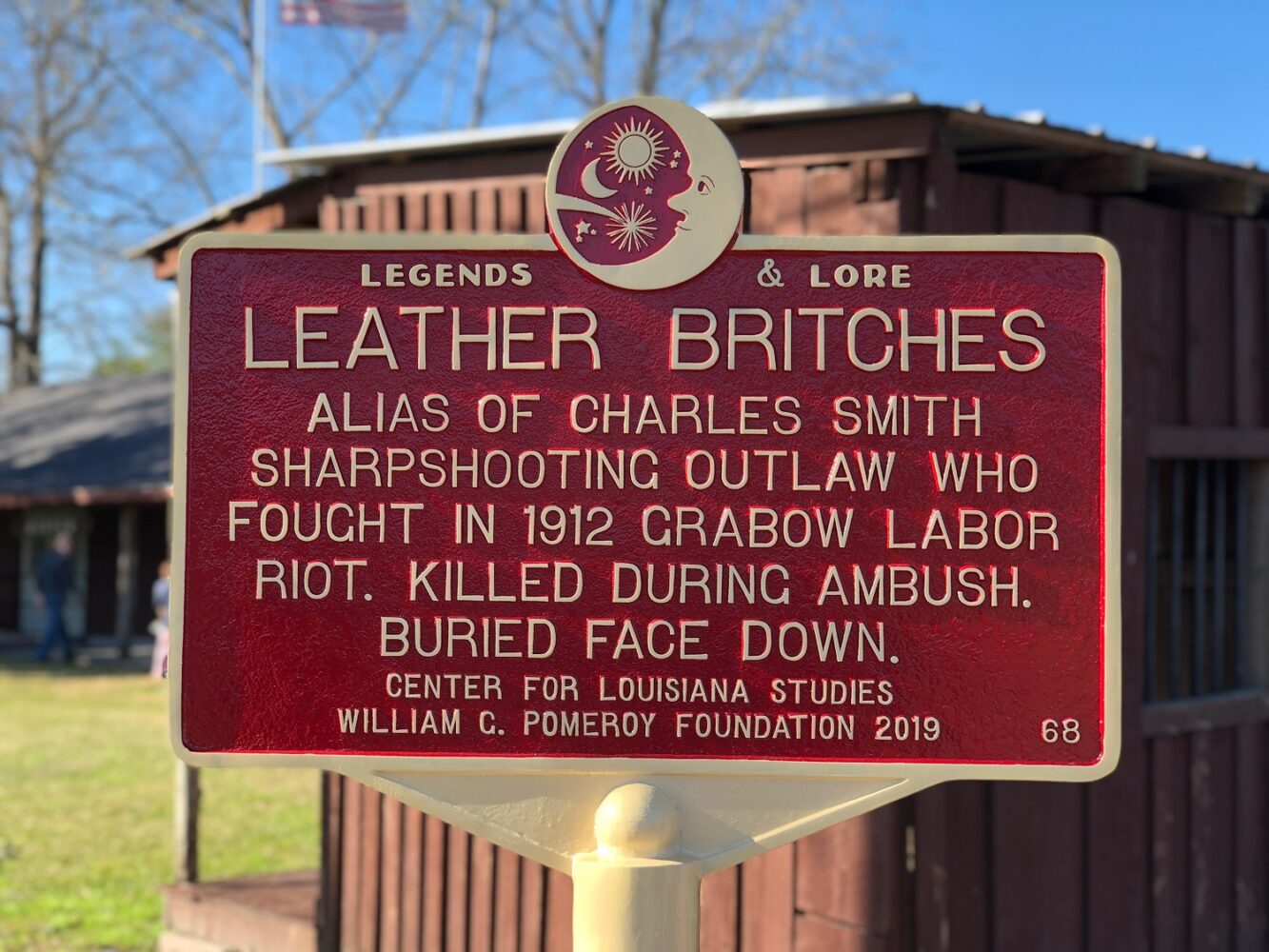Leather Britches Smith
The legendary outlaw Charles “Leather Britches” Smith is best known for his armed defense of his fellow union members during the Grabow Riot of 1912.

William G. Pomeroy Foundation
Located in Merryville, Louisiana, this historic marker is part of the William G. Pomeroy Foundation's Legends and Lore initiative.
Charles “Leather Britches” Smith is a legendary Louisiana figure and outlaw best known for his armed participation in the so-called 1912 Grabow Riot, during which he defended his fellow Brotherhood of Timber Workers union members from armed guards.
The outlaw known as Leather Britches arrived in Merryville in 1910. His true identity remains a mystery. Charles Smith, accounts claim, was an alias, and many believe the nickname “Leather Britches” may have come from the thick leather chaps the man wore to navigate through the brush of western Louisiana’s pinewoods.
By all accounts Leather Britches was an expert woodsman. He would often sleep in dense patches of pine forest to avoid capture by local officials or sometimes camp along the thickets growing in river bottomlands. He also frequently stayed near an old pump house on a stretch of railroad track between Merryville and Deridder.
A few facts color the brief time the man spent in Merryville before he was ambushed by a posse of local men led by Deputy Sheriff Del Charlan. At the time of his death, Leather Britches was in possession of two Colt pistols and a Krag-Jørgensen rifle. It was his skill with these guns that turned him into a legendary figure.
Legends say Leather Britches was a deadly shot. With a pistol he could shoot purple martins in flight and a fox squirrel on the run. With his rifle he could hit a hawk soaring in the sky. Stories often describe Leather Britches sitting in the local theater with his two Colts laying on his lap, his fingers on the triggers and their barrels crossed. He would come upon a local home, pull one of his Colts from its holster, shoot a chicken’s head “clean off,” as people say, and toss the bird to the lady at home to cook for his supper. Neither townspeople nor the law dared to challenge him. No one believed anyone could outdraw him.
Other local stories, however, suggest that Leather Britches was a sort of hero. Legends claim he worked for the Brotherhood of Timber Workers union and had joined the marchers that July in 1912 when the union protested at the Grabow mill. Many say that during the violent shootout that occurred that day, Leather Britches was the only union man carrying weapons and that he single-handedly held off a slew of armed mill workers and hired guards who sought to quell the growing unionism in the region through violence. Newspapers printed that at least forty men were wounded at “The Grabow Riot”, and four people died. A few days later more than sixty union men were indicted for sedition. All were arrested except Leather Britches.
The time Leather Britches spent avoiding capture only cemented his legendary status. However, he was eventually found sleeping under a log car. The shootout between Leather Britches and the local posse occurred in September 1912. When one of the deputies ordered him to surrender, Leather Britches grabbed for his pistol but was gunned down by the deputies. Rumors soon spread that Leather Britches’ partner shot him while he was asleep and that deputies riddled his body with bullets to cover up the murder and close the case for good.
Most of the local populous believed Leather Britches was actually East Texas fugitive Ben Myatt, but when a Texas deputy traveled to Merryville to identify the body, townspeople were shocked when the officer concluded the dead man’s eyes were not the right color.
Left with the body of the outlaw whom some admired and others hated, the town faced a difficult decision. Supporters believed Leather Britches deserved a proper burial inside the Merryville Cemetery. Others did not. Legends say a compromise was reached and his grave was placed right on the cemetery’s fence line. For years a homemade wooden marker could be found in the spot, marking the place that holds the body of legendary Leather Britches Smith. Today a red aluminum Legends and Lore marker commemorates Leather Britches and is the Pomeroy Foundation’s first such marker in the state.
